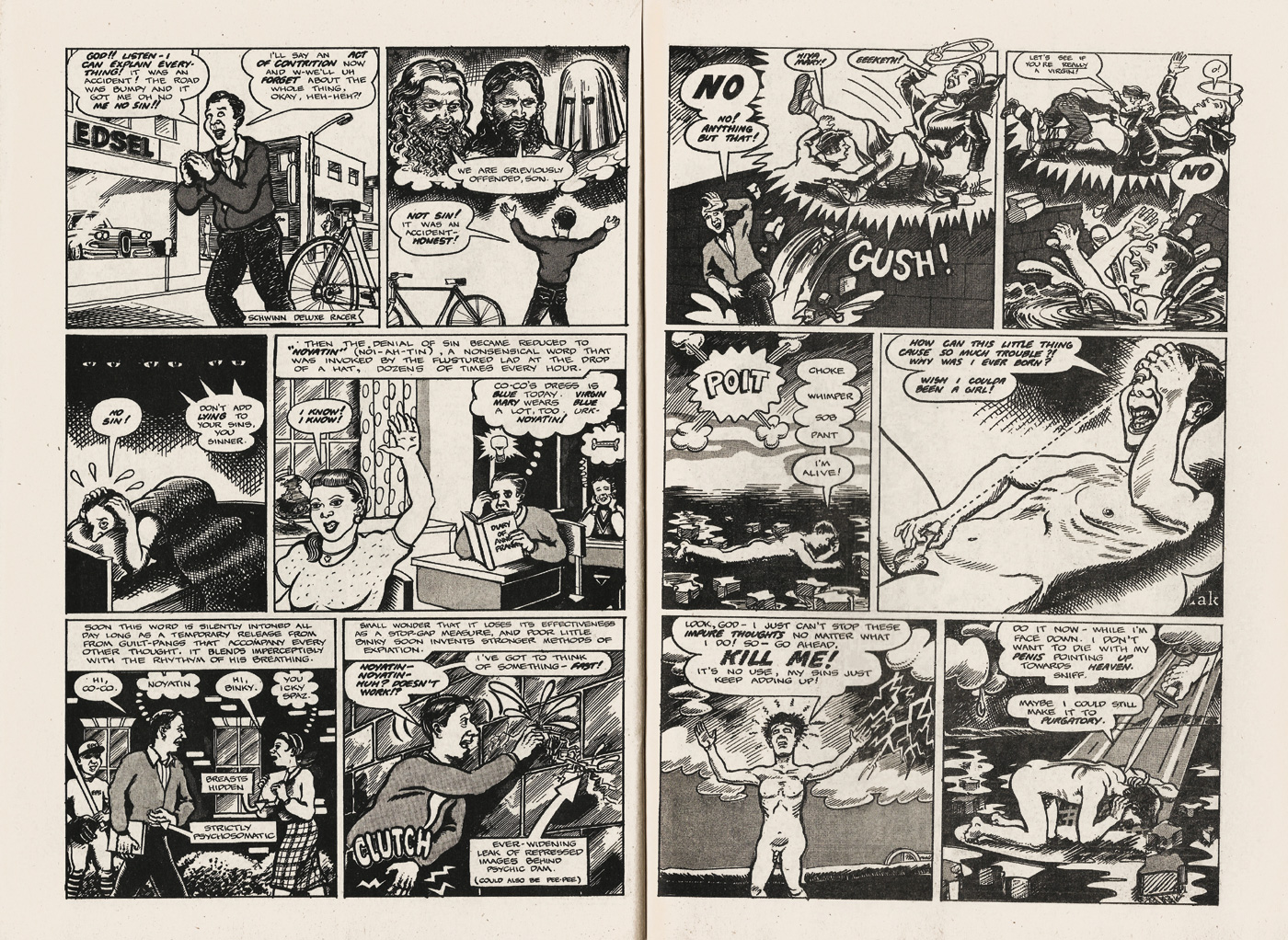GREEN Justin Considine
(Chicago 1945)
Binky Brown meets The Holy Virgin Mary
Luogo: Berkeley
Editore: Last-Gasp Ego-Funnies
Stampatore: senza indicazione dello stampatore
Anno: 1972
Legatura: brossura
Dimensioni: 25,5x18,3 cm.
Pagine: pp. 44 n.n. compresa la copertina
Descrizione: prima e quarta di copertina illustrate a colori. Albo a fumetti interamente illustrato con disegni in bianco e nero. Prima edizione.
Bibliografia: N. D.
Prezzo: € 150ORDINA / ORDER
«Binky Brown» è considerato uno dei primi esempi di graphic novel autobiografico. Green racconta qui la propria infanzia afflitta da un profondo senso di colpa a causa di una rigida educazione cattolica, con le relative reazioni irrazionali e compulsive che ne derivano. Binky Brown, alter ego dell’autore, immagina che qualunque oggetto si assimili anche solo lontanamente a un fallo, emetta una sorta di «raggio penico» che egli non deve assolutamente toccare. Non si tratta solo di una confessione rivelatrice delle ossessioni e dei più intimi desideri ma di una vera e propria analisi fenomenologica della propria nevrosi, clinicamente identificabile col termine di «scrupolosità», una forma di disturbo ossessivo compulsivo in cui i pensieri religiosi e morali producono ansie e sensi di colpa che compromettono la vita sociale e l’adattamento, con ripercussioni anche sulla sfera cognitiva. Nelle prime pagine del fumetto il piccolo Brown mentre gioca rompe una statua della Vergine, e subito i suoi pensieri si fissano sull'idea che possa accadere qualcosa a sua madre. Inizia così un doloroso percorso in cui senso di colpa e timore della catastrofe conducono il piccolo protagonista verso la reiterazione di azioni quotidiane che lo distolgano dalle proprie ossessioni. E' lo stesso autore che nel testo introduttivo parla della propria opera non solo come di un prodotto di intrattenimento ma come un atto di purificazione, di liberazione dalle proprie paure, e in quarta di copertina aggiunge: «Must Reading for Neurotics of All Creeds». per questo «Binky Brown» può essere considerato anche come il primo fondamentale esempio di «graphic medicine», il cui manifesto, firmato da K Czerwiec, Ian Williams, Susan Merrill Squier, Michael J. Green, Kimberly R. Myers e Scott T. Smith, è del 2015.
Testo introduttivo: "A confession to my readers. O, my readers, the saga of Binky Brown is not intended solely for your entertainment, but also to purge myself of the compulsive neurosis which I have served since I officially left Catholicism on Halloween 1958. You may deem my material as being too indulgent, morbid and obscene. I daresay many of you aspiring revolutionaries will conclude that instead if focussing on topics which would lend themselves to social issues I have zero'ed-in on the petty conflict in my crotch! My justification for undertaking this task is that many others are slaves of their neuroses. Maybe if they read about one neurotic's dilemma in easy-to-understand comic book format these tormented folks will no longer see themselves as mere food-tubes living in isolation if all we neurotics were tied together we would entwine the globe many times over in a vast chain of common suffering... please don't think I'm an asshole, amen".
Nota al colophon: "It's not my fault if young catholic children mistake this comic for treasure chest and then get fucked-up for life. Dealers are instructed, under pain of mortal sin, not to sell it to them. It's probably a venial sin even to sell this comic to adults".
Testo introduttivo: "A confession to my readers. O, my readers, the saga of Binky Brown is not intended solely for your entertainment, but also to purge myself of the compulsive neurosis which I have served since I officially left Catholicism on Halloween 1958. You may deem my material as being too indulgent, morbid and obscene. I daresay many of you aspiring revolutionaries will conclude that instead if focussing on topics which would lend themselves to social issues I have zero'ed-in on the petty conflict in my crotch! My justification for undertaking this task is that many others are slaves of their neuroses. Maybe if they read about one neurotic's dilemma in easy-to-understand comic book format these tormented folks will no longer see themselves as mere food-tubes living in isolation if all we neurotics were tied together we would entwine the globe many times over in a vast chain of common suffering... please don't think I'm an asshole, amen".
Nota al colophon: "It's not my fault if young catholic children mistake this comic for treasure chest and then get fucked-up for life. Dealers are instructed, under pain of mortal sin, not to sell it to them. It's probably a venial sin even to sell this comic to adults".




